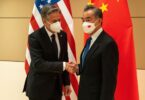China’s 2021 defence spending will rise 6.8% as compare to 2020, slightly high from last year’s increase. Premier Li Keqiang pledged that efforts to strengthen the People’s Liberation Army, which is developing an array of weapons from stealthy fighter jets to aircraft carriers, would continue a pace in the face of what China views as multiple security threats. The stated spending figures are 1.35 trillion yuan ($208.47 billion) in the national budget release, is closely watched as a barometer of how aggressively the country will beef up its military.
Prime Minister, Li said in his state-of-the-nation address that the government would strengthen the armed forces through reform, science and technology and training of personnel. According to him, military training will be boost and preparedness across the board, make overall plans for responding to security risks in all areas and for all situations, and enhance the military’s strategic capacity to protect the sovereignty, security and development interests of our country.
China is a one of the world superpowers and second largest economy of the world. Presently, it has all capabilities and potentials to become the World’s first largest economy and sole power if its ongoing development and innovations program do not hamper by internal and external factors. While perceiving the future rise of China as a threat to its International supremacy, United States pre-emptily started taking measures to stall China’s growing influence at world level. As defensive measures in its first step, US halted Chinese influx of imports by imposition of higher tariffs and huge Chinese investments in its stock exchange and businesses. United States government hunted Chinese global tech giants to curb China’s access to US sensitive defense and industrial technology. The American polices not only hamper Chinese businesses but also affect Chinese technological advancement in the fields of Research and Development (R&D). Therefore, Chinese has allocated funds to improve the defence-related R & D, and industry, along with defence mobilization system.
Despite the serious threats posed by the trade war and technology blockade by the United States, China is facing challenges to its sovereignty and territorial security from the US and its allies in the region and beyond. While looking China’s internal Security Challenges are Xinjiang and Tibet separatist movements, Hong Kong pro-democracy movement and Taiwan resistance to ingulf Chinese regime in future. While making the situation worst for China, America and allies are supporting these internal separatist forces in the name of democracy, human rights. and freedom. On other hand, external challenges to China’s security are US missions in the disputed South China Sea, Islands dispute with Japan, border dispute with India and unstable Afghanistan with significant presence of NATO and US Troops alongside presenting a heaven to anti-China terrorist elements. United States had formed a block consisting China’s regional rivals including Japan, India and Australia to contain China’s political and economic influences and military threshold in the region. The four members Quad Security dialogue has emerged as strategic partnership of the four nations against China. Few days back, US Secretary of State Antony J. Blinken offered a policy statement said that China is the biggest geopolitical challenge that United States faces in the 21st century. The new US Secretary of State has clearly charted out his policy objectives regarding China, Which intent that US harsh policy toward China is likely to continue during Biden era. Chinese government is also evolving its defense and economic options according to new challenges, however, US’s containment policy has increased the mileage for China to achieve its destination.






